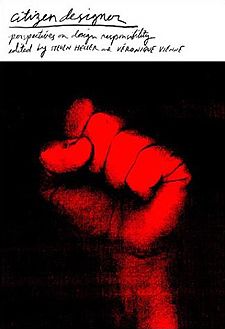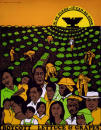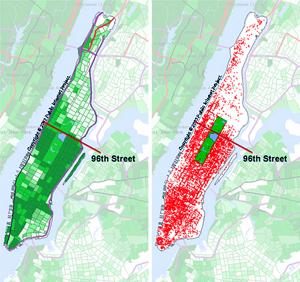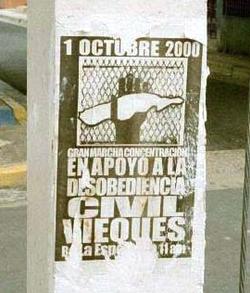May 2003
Citizen Designer: Perspectives on Design Responsibility
There are many things I’m looking for in a book on design responsibility: some historical perspective, some global perspective, a sense of urgency, a rigorous analysis of the relationships between design and society and the world we live in.
Sadly Citizen Designer: Perspectives on Design Responsibility is none of these things.
 The book is collection of essays and interviews edited by Steven Heller and Veronique Vienne, mostly, it seems, from the last 5 years and almost entirely from the United States.
The book is collection of essays and interviews edited by Steven Heller and Veronique Vienne, mostly, it seems, from the last 5 years and almost entirely from the United States.
Despite the title, there is almost nothing about civic design. Almost nothing about design that facilitates participation in public life. Nothing about consumer labeling, information mapping, civic wayfinding, or universal design and accessibility. Nothing about the role of design in the manufacture of consent, or how design shapes our assumptions about what is normative.
Still, though several of the essays fall flat, there are some tasty ideas to be found. The book is divided into four parts: “Social Responsibility,” “Profressional Responsibility,” “Artistic Responsibility,” and “Rants and Raves.”
Appropriation and cooption are themes that run through many of the essays. From the professional side (Don’t steal those proprietary fonts, Plagiarism is bad) to the cultural and political side. In his account of the young, hip “account planners” of the advertising industry and their use of anthropology, Tom Frank details the cooption of the rhetoric of democracy, resistance, revolution, authenticity, and individualism in the service of corporate marketing. The essay and Frank’s other work are highly recommended for design students packing their portfolios with zany and illegible self-expression.
In “Good Citizenship: Design as a Social and Political Force,” Katherine McCoy notes another kind of cooption:
“American designers consistently take European theories and strip them of their political content. Of the various strains of modernism, many of which were socially concerned or politically revolutionary, American design either chose those most devoid of political content or stripped the theories of their original political idealism.”
Indeed, several essays in the book reduce social responsibility to acts of personal salvation. Robbie Conal notes his guerilla street postering is a way of venting pent-up frustration. Gunnar Swanson’s winding essay on plagiarism ultimately settles on the fact that plagiarism is bad because it makes the “spiritual act” of designing into a “mechanical” one. The one essay on architecture is heavy on spirituality, theology, and the ethics of building. I would put all of these things into broader context. On architecture, for instance, I would have included an essay on building green, on design for public and alternative transportation, or an introduction to urban planning. Instead, discussion of affordable, accessible housing is relegated to a single mention in a footnote.
A couple of the essays locate the construction of apathy and a-politicism in design schools and design education. McCoy notes that “most introductory graphic design courses are based on abstract formal exercises inherited from the Bauhaus and the classic Basel school projects.” Design is taught as a matter of forms, color, and spacing in a visual laboratory sealed off from the world at large. The question, then, is what would a progressive design curriculum look like? How does one teach political awareness?
One exercise is given by Anne Bush. Her students are asked to study similarities and differences between intended meaning and response. “The ultimate goal for students is to recognize that meaning is always the result of a range of cultural and social negotiations and the designer is not the sole determinant, but rather a participant in these dialogues.”
Bush cites an analysis by her student Erica Wong. A poster campaign developed by the Mexican government to promote health and nutrition was interpreted entirely differently by its intended audience. The poster features a single black and white photo of a boy in traditional dress, smiling under banner type.
“The photography becomes attempts to capture indigenous culture as a kind of romantic and static essence. It becomes a kind of visual anthropology that says more about the conceptions of its makers than the reality of its intended audience. Wong, discovered through interviews with the local communities that many people misunderstood the intention entirely. For citizens bound by a strong sense of community and family, the boy in the image appeared abandoned. The people of the villages couldn’t understand why he had been left alone. They also couldn’t reconcile this sense of isolation with the posed quality of the photograph. If he was alone, why was he smiling for the camera? The synthetic, portrait-like framing combined with the celebratory dress (normally saved for special occasions) further confused the reading. Many said they initially overlooked the poster, because they thought it was an advertisement for tourism, since similar portrait images of traditional culture (usually in black and white) were a common visual theme in the marketing of Mexican heritage. Wong reminds us, however, that although depicting indigenous culture in black and white is a common representational practice it reinforces nostalgic ways of seeing and continues to locate indigenous culture in a perpetual past. Moreover, it differs greatly from the sense of color and activity that is a part of everyday reality in rural Mexican communities. For the local population, then, the poster not only mirrored the imagery of travel and promotion, but, unfortunately, also served to reinforce regional fears of government encroachment and the dissolution of traditional ways of life.”
Another running theme among several essays is the ethical relationship between design and big business. How should good designers respond to bad corporations?
Ad man Chris Riley tries to distinguish between the “business idea” and the “business model.” The abstract idea of selling a great product or relationship to a customer is opposed to the sometimes harful ways this is actually implemented. “Business” has lost its way, says he. “Business exists to serve human needs and desires, not capital requirements.” Businesses focused on maximizing return on investment “have become disconnected from their customers, employees, and shareholders.”
Another essay provides a hard look at “cause related marketing,” “a creative strategy that ties a company and its products to a social issue or cause with the goal of improving a weak public image and boosting sales, while providing benefits to a worthwhile charity.” Examples include corporations like Ben & Jerry’s, the Body Shop, McDonald’s, Reebok, Denny’s, and Chevron that sell their public works to improve their brand image, and in many cases as a way of fending off negative publicity. The skepticism of the article is welcome, citing investigations the reveal the spotty truth behind the wholesome claims of Ben & Jerry’s and the Body Shop. But the author does seem to have an axe to grind: comparing Ben & Jerry’s charitable donations to net sales instead of net profits is misleading.
Neither article suggests a way forward. Perhaps because both essays neglect a simple structural point: the corporate structure itself limits legal and financial liability and public corporations are designed to maximize shareholder return. How does one integrate social responsibility into this? Of the companies cited, Ben & Jerry’s maintains the most advanced corporate code of conduct, but it is apparently not enough to hold them to their word.
One model on the environmenal front is corporate Germany. With the largest economy in Europe, Germany has increasingly progressive laws on the use of recycled materials, waste reduction, and the use sustainable energy sources. Susan S. Szenasy paraphrases one of her industrial design students, “We have to look at the full life-cycle costs of materials, from resource harvesting to processing to manufacturing to distribution to use and recycling, or better yet, working to engineer materials for nontoxic degradation.” Ultimately, it’s up to us organize, to move our governments to tighten the rules under which corporations operate, or to develop another alternative. Designers, who know all about the materials they use, could play an important part in such campaigns.
Victor Margolin’s answer to the evils of big capitalism is to go small. His essay hails the rise of the design/entrepreneur, a kind of small producer facilitated computer aided design, the internationalization of manufacturing, and the ability to produce small custom batches for discreet markets. The examples of sustainable products developed by designer/entrepreneurs and associated community design workshops in developing countries are rightly celebrated. And, it’s conceivable that a smaller operation would do less damage and would put more control of the conditions of manufacturing into the hands of the individual designer/entrepreneur. But small scale manufacturing that takes advantage of manufacturing where environmental and labor protections are lacking... is still taking advantage of those conditions. A smaller sweatshop is still a sweatshop.
Yet even when the essays fail, they often raise important questions.
The essay “Healing with Design” abuses the language of science, making wild logical leaps to justify its new age theory of “vibrational medicine.” A fact check with a physics grad student could have saved some paper here. The essay, however, makes we wonder just how much of the effects of color are cultural and how much are biological? On that note, some notes on the cultural connotations of color environments and their responsible use would also be useful, for instance for designers working in one culture whose designs will be seen in another, say, on the Web.
David Vogler’s list of examples of irresponsible design is mostly absurd. To pick one example, The New York Times’s use of color printing is irresponsible... because it rejects a history of black and white printing? Of the Times’s serious ethical lapses, I would not list color printing as one of them. But, the exercise of developing an “index of irresponsibility” is a useful one. What criteria would one use? What patterns emerge? Why? And what should be done?
The J.D. Biersdorfer’s breezy essay on responsible Web design touches on some general issues of usability as responsibility towards one’s user (“Deception is another irresponsible practice.”) But Don Norman, in his excellent interview, makes the deeper case for usability testing and the incorporation of user feedback into the design process. Again design schools are fingered for their failure to teach this.
“Designers learn about aesthetics. They seldom learn about human psychology.... Humans are fallible. Learn that. Cherish that.... Design for people as they are, not as you would have them be. Design for inefficient users. Design for creative, imaginative people who will do things with your design that you never have dreamed of, things both good and horrid. Design for people who are tired and stressed, cranky and irritable, sloppy and inattentive. In other words, design for real people.”
This makes me wonder why the issue of design standards is wholly ignored. More designers should be aware of accessibility standards like section 508, that make Web pages easier to read for persons with different visual abilities, and coding standards set by the World Wide Web Consortium that govern the layout properties of HTML — not to mention the consensus based process by which those standards are set. Other design standards such as our national signage system or the ubiquitous nutrition facts label also deserve comment as an important area where design can contribute to society.
Several critical essays take on “culture jamming.” Little acts of civil disobedience are all well and good, but I’m not much convinced of the revolutionary potential of culture jamming. Several essays happily point out the apparent contradiction that the profiled culture jamming activists are also well employed by the advertising industry. And this actually does not strike me as a contradiction — both advertising and culture jamming occupy the same media space and market place. How exactly are Shawn Wolfe’s and Shepard Fairey’s “brands without a product” examples of responsible design? As a criticism of consumerism, the ironic slogan “OBEY” does not encourage much skepticism.
I would have dropped Jeffrey Keedy’s abusive rant on culture jamming, for Tom Keefer’s analysis of why the Adbusters school of action is a political dead end. His three main reasons:
“Their privileging of resistance in the individual act of consumption over the collective organization of production, their view of revolution as consisting of a purely subjective and highly individualized ‘mindshift’, and their insistence that the ‘revolution’ will be made on behalf of the masses by a small group of ‘culture jammers’.”
A more interesting use of corporate imagery for a broader social movement is detailed in Teal Triggs’s essay on the May Day actions in London, 2001. Activists chose the imagery of Parker Brother’s Monopoly board game as the overarching image framework for a host of autonomous direct action events planned around the city. Rather than trying to ironically subvert the symbols of the game, activists used imagery and narrative to give a visual consistency to promotion of their activities: posters of modified property deeds announced the sites of protests, or were modified with slogans like “homes not hotels.” “Get out of jail free” cards were circulated with legal information and tips on what to do if arrested. The board layout itself was used to publicize a critical mass bike ride around London.
The metaphor of the game, monopoly capitalism, was used as the narrative link between work on the environment, animal rights, fair housing, etc. and the overarching criticism of the roots of the various ills in capitalism itself. As the May Day Monopoly Guide states, the protestors vowed to bring “the whole game to an end.”
One of the best essays is on role of law in protecting and promoting brands. Like “free trade” of goods, the “free trade” of corporate brands does not just happen, nor is it an absence of rules and smaller government. It is engineered, legislated, and protected by government and international treaties. In fact “free trade” is often extremely protectionist — open your markets to us while we raise the barriers for you. For example, in August 2001 the International Trademark Association suggested revisions to legislation creating the Free Trade Areas of the Americas.
“INTA argues that signs and symbols belonging to indigenous peoples, local communities, and African-Americans should not be entitled to any form of intellectual property protection. Quoting their report:
“[INTA] has also expressed concerns regarding proposed protection for the words and symbols of New Zealand’s indigenous people, the Maori.... The terms ‘indigenous’ or ‘afro-American’ communities would require careful definition, and would be subject to greater potential controversy. The term ‘local community’ is such a broad and indefinite term that is has the potential to allow almost any city, village, or group to claim rights in signs that may have been used commercially for years, by others.”
David Reinfurt’s chapter on “Open Source Design” confuses Open Source with Free Software. (He links to the GNU Web site of the Free Software Foundation... which has an essay or two on the difference between Free Software and Open Source.) Furthermore, Reinfurt’s examples of “open source design” are not very open source. In one project, the public can submit contact sheets of tourist photos as long as they include the letters B, E, R, L, I, and N, in that order. In another, the facade of the former East German housing ministry that changes it’s facade as its windows are open and closed. These are interactive, but not open source. But more importantly, the author/designer depoliticizes the issue. The Free Software movement is not just blossoming because it’s cool to share and collaborate, or that sharing and collaboration produces better software. It is also a movement to preserve and extend the freedom to do so, and an attempt to prevent our cultural output from being wholly privatized. One of Richard Stallman’s essays would have been a better choice to explain Free Software, though for non-software or documentation projects, a look at the Creative Commons licenses might be more appropriate.
If this review focuses heavily on what the book is not, it’s because I am disappointed with what is here. For instance, several essays refer to the First Things First manifesto, to William Morris, and the Bauhaus. I would love to have some of these primary documents bound in a single volume. This, however, is not that volume.
Heller writes in his introduction, “Our goal in editing this book is not to offer dogmatic degrees or sanctimonious screeds but to address the concern that the design field, like society as a whole is built on the foundation of... well, you fill in the blank.”
Is this fear of domga what chases the rigor away?
Susan S. Szenasy writes of the lessons of her design ethics class: “Design, as Gropius saw it (as Morris did before him), has a significant contribution to make in the reshaping of institutions as well as our lives.”
I believe this is true. And is just as critical as ever. Though while some essays in Citizen Designer are provacative, the book is hardly the call to action it should have been.
Citizen Designer: Perspectives on Design Responsibility is published by Allworth press. It lists for $19.95.
Green, Low-Income Housing in Santa Monica
Colorado Court is a 5-story, 44 unit single room occupancy apartment complex for low income tenants in Santa Monica. It is also one of the first buildings of its kind in the United States that is 100% energy independent, generating nearly all its own energy for electricity, heat and light.
Architectural Review, November 1, 2002:
 “In both siting and form, the building has been designed to exploit passive environmental control strategies such as natural ventilation, maximizing daylight and shading south-facing windows. But it also incorporates a number of innovative energy generation measures, notably a natural gas-powered turbinecum-heat recovery system that generates the base electrical load and services the building’s hot water needs. Photovoltaic panels set in the walls and roof supply most of the peak-load energy demand. This co-generation system converts natural gas into electricity to meet the building’s power needs. The same system also captures and uses waste heat to produce hot water and space heating for residents throughout the year. Unused energy from the photovoltaic panels is returned to the grid during the day and retrieved at night as needed. The architects estimate that these energy generation and conservation systems will pay for themselves in less than 10 years and annual savings in electricity and natural gas bills should average around $6000....
“In both siting and form, the building has been designed to exploit passive environmental control strategies such as natural ventilation, maximizing daylight and shading south-facing windows. But it also incorporates a number of innovative energy generation measures, notably a natural gas-powered turbinecum-heat recovery system that generates the base electrical load and services the building’s hot water needs. Photovoltaic panels set in the walls and roof supply most of the peak-load energy demand. This co-generation system converts natural gas into electricity to meet the building’s power needs. The same system also captures and uses waste heat to produce hot water and space heating for residents throughout the year. Unused energy from the photovoltaic panels is returned to the grid during the day and retrieved at night as needed. The architects estimate that these energy generation and conservation systems will pay for themselves in less than 10 years and annual savings in electricity and natural gas bills should average around $6000....
Details such as fluorescent lights which automatically extinguish when a room is not in use, insulation made from recycled newspapers, a bike store, CFC-free refrigerators and a trash recycling room reinforce the evangelical message. As many of the technologies are relatively unproven, it is hoped that in its intelligent exploration of the potential of sustainability, the building will act as a successful demonstration project for developers, planners, politicians, architects and, most especially, the wider public.”
The apartments themselves are 375 square feet studios with a kitchenette and a small bathroom. Shared areas include a lounge, laundry, and courtyard.
The project falls under Santa Monica’s “Sustainable City Program” which tries to reduce electricity and water consumption, and install photovoltaic cells on in public and private projects.
Los Angeles Times, June 26, 2001:
“A host of public and private entities—including the cities of Santa Monica and Irvine, Southern California Edison and the California Energy Coalition—are involved in planning, funding and monitoring the innovative building. The two cities, the conservation group and the utility have formed a group known as Regional Energy Efficiency Initiative, which has contributed about $250,000 to energy-saving devices in the building. In addition, Santa Monica itself is contributing about $250,000 toward electricity generators.
The building will be loaded with energy-saving and environmentally benign or ‘sustainable’ devices. Heat from the micro-turbine will produce hot water, eliminating the need for a conventional water heater....
 Prevailing breezes will cool the building, which will have no mechanical air conditioners. The U-shaped structure ‘acts like a giant wind scoop,’ said architect Larry Scarpa, a principal of Santa Monica-based Pugh & Scarpa.
Prevailing breezes will cool the building, which will have no mechanical air conditioners. The U-shaped structure ‘acts like a giant wind scoop,’ said architect Larry Scarpa, a principal of Santa Monica-based Pugh & Scarpa.
In yet another ‘green’ flourish, the building will collect all the rainwater from the alley behind the property and funnel it into a series of underground chambers. The water will slowly percolate back into the soil, which will filter the pollutants from the water while preventing contaminated water from spilling into Santa Monica Bay. The drainage system was paid for separately by the city of Santa Monica.
The concept of a building that would be energy self-sufficient emerged about two years ago, when Santa Monica officials met with members of the California Energy Coalition. The city’s Housing Division, which funds construction of low-income housing, chose to make a low-income housing project into a dream project of ‘green’ construction, and Colorado Court became the target.
‘We needed a demonstration project because a lot of developers feel that the technologies are unproven,’ Raida said.
 A number of apartment buildings in Santa Monica and Irvine are to be equipped with energy-saving technology by the Regional Energy Efficiency Initiative, but the Santa Monica building is the only project attempting to provide its own power as well.
A number of apartment buildings in Santa Monica and Irvine are to be equipped with energy-saving technology by the Regional Energy Efficiency Initiative, but the Santa Monica building is the only project attempting to provide its own power as well.
Rebates from the state Energy Commission helped defray the high cost of the energy-generating equipment. The state’s rebate on the solar panels, which cost about $225,000, will be about $62,000. The $57,000 micro-turbine and heat exchanger will yield a $15,000 rebate from Southern California Gas Co.
If recent research and development has yielded new ways of conserving energy and producing electricity, regulations and building codes have not kept pace.
In one instance, architects had to obtain special permission from the city to hang solar panels outside the exterior stairwells because building inspectors said the solar panels ‘enclosed’ the stairwells and triggered requirements for floors, ceilings and fire-rated walls.”
Santa Monica Mirror, December 6-12, 2000:
“[Architects] Pugh Scarpa Kodama and the Community Corporation have been working with the City of Santa Monica and Southern California Edison to come up with an ‘incentive-type’ plan, which would allot a certain amount of energy to each resident per month, and would award those who did not use the full amount with rebates on their energy bills....
Colorado Court’s units will rent for between $316 and $365. They will be available to low-income residents culled from the Community Corp’s waiting list, who meet the low-income requirements for this building. Twenty-two units will be rented to people making less than $12,775 yearly, another 22 to those making less than $14,600 yearly (these figures are based on 35 - 40% of the current median income of $36,500). According to Raida, the typical demographic for a building such as Colorado Court would include full time workers earning minimum wage, and people on fixed incomes such as retirees and the disabled.
The Community Corp’s waiting list currently numbers over 1,000 people.”
It’s great that the org’s and the city could pull together $5.8 million to build high-tech, green, low-income housing. But, experimenting on the poor for their demonstration project? Is this the flip side of environmental racism? Get some low-income tenants to live inside your the unproven technology? No air conditioning in Southern California? An experimental powerplant in the basement, and less-than-fire-rated exterior walls... that cover a fire exit? Evangelical indeed.
Operation Wake The Fuck Up
From Boston IndyMedia:
 “On the evening of May 20, Direct Action anti-authoritarian activists from the White Mountain Autonoma, AnarchoNinjas, and the Trained Monkee Collective came together to ‘tag’ every pay phone in Nashua, NH with a sticker that reads, ‘This Phone is Bugged’ in large letters, citing the relevant section (Section 215) of the Patriot Act 2001 authorizing this in smaller print. An example of the stickers may be viewed at http://www.crimethinc.com/cards/28_med.gif. The stickers are placed upon the telephone receivers.
“On the evening of May 20, Direct Action anti-authoritarian activists from the White Mountain Autonoma, AnarchoNinjas, and the Trained Monkee Collective came together to ‘tag’ every pay phone in Nashua, NH with a sticker that reads, ‘This Phone is Bugged’ in large letters, citing the relevant section (Section 215) of the Patriot Act 2001 authorizing this in smaller print. An example of the stickers may be viewed at http://www.crimethinc.com/cards/28_med.gif. The stickers are placed upon the telephone receivers.
Intended to create situations where the average mass media-deadened citizen of Nashua is confronted with the current political reality of life under Bush II and his attack dogs of Homeland Security, Nashua was chosen as the introductory site for ‘Operation Wake The Fuck Up’ due to its large population, strategic location on the NH-Massachusetts border (thousands of Bay Staters shop in Nashua daily to avoid Massachusetts sales tax), and the critical role it plays in the NH Presidential Primaries as the first large population block to report its’ poll returns.
There are approximately 400 pay phones in Nashua, locate in the various shopping malls, pubs, public buildings, stores, restaurants, and hotels - including the 8 pay phones in the lobby of the Sheraton Tara, preferred home-away-from-home for Bush II when in the greater Boston area, due to its isolation and ‘security’.
Additional activities are planned for the near future, including mock ‘stop-and-search’ actions, imitating the activities of Homeland Security and its componant bureaus and agencies. These will be very similar to the mock ‘search-and-destroy’ missions used to great effect by Vietnam Veterans Against The War during the anti-Vietnam War years, in which activists, dressed as ordinary people, are pulled out from the innocent spectators and are mock-abused in true government style.
Activists wishing to join the fun may contact the White Mountain Autonoma at [email protected].”
Bush launched his presidential campaign just last Friday. The New Hampshire primary takes place on January 27, 2004, a mere 35 weeks from now.
Print out the stickers yourself or buy a pack online.
Thanks, American Samizdat
Stylish Housing that Fights Pollution
 How do you turn massive liability into a premium asset? Green, green, green.
How do you turn massive liability into a premium asset? Green, green, green.
Take contaminated industrial brownfield, haul away 5 feet of poisonous dirt, add architecture and planning firm, solar heating, wind power, green roofs, gardens that extract pollutants from the soil, huge argon-insulated windows, a view of the coastline and Web accessible remote control.
Then stand back and marvel at the chic elegance of Tango, a designer housing complex in Malmo, Sweden. The complex also recycles its waste water into a rebuilt marsh ecology that mimics the development’s east side, the marshy ecology of the sound. In passing the article mentions that the construction methods and materials were “hewed to ecological building standards that Malmo had set for the district.”
It’s all very geeky and cool, but I look forward to the day when sustainable design is boring and mandated outside of northern Europe, too, not just left to showcase projects that benefit those that can rent at three times the market rate or that make great PR when they pave over industrial contamination.
Dell: Recycling with Prison Labor
“The Computer TakeBack Campaign is protecting America’s public health by promoting corporate accountability for electronic waste.
Tens of million of computers become obsolete every year and less than 10% are collected for recycling, with the rest of them stored in homes and offices, disposed in landfills and burned in incinerators, and shipped to poor countries for dismantling under horrific conditions. Newer, faster, smaller, and cheaper products hit the market every day - all of them toxic, most of them designed for disposal rather than reuse and recycling, and, once obsolete, are ignored by the very companies that profit from short life-spans and cheap design.
Currently, the expense of collecting and managing discarded electronics is borne by taxpayer-funded government programs. Public policy and corporate practice have failed to promote producer take back and clean design. The principle of producer take-back shifts the burden for collection and recycling costs off of taxpayers and government to the producers, providing an incentive for companies to market products that are durable, less-toxic, and recyclable....
The Computer TakeBack Campaign was formed to promote clean design and brand owner responsibility for discarded computers and electronics.”
The campaign was launched on November 27, 2001 with the release of the Silicon Valley Toxics Coalition’s 3rd Annual Computer Report Card. The annual report measures the environmental qualities of electronic equipment and the environmental performance of companies. The report noted that several major U.S. computer companies ran TakeBack programs in Europe, but not in the United States.
Dell was singled out as the focus for the first major campaign. Dell has the largest share of the U.S. and global personal computer market, and are the leading seller of computers to institutions. The Computer TakeBack Campaign is also targeting Dell “because the company’s sales and distribution model uniquely positions it to establish an effective national take back system for used and discarded products.”
After a long campaign and a much public pressure, on March 19, 2003, Dell announced it’s new curbside recycling program. As of March 25, consumers in the continental U.S. could “order home pickup of unwanted notebooks, desktops, monitors, and other select computer equipment for $15 per unit.”
Dell, however, is using prison labor to do the dirty work of recycling its electronics.
A friend of laughingmeme writes:
- Dell still contracting with prison labor to do recycling... prison labor is a low-road solution which relies on ‘high tech chain gangs’ and thwarts the development of a legitimate recycling infrastructure... and prison laborers are handling toxic computers and OSHA standards are not enforced as they should be
- Dell still charging a fee at the back-end (instead of implicit in purchase price) for the pick-up, which is a disincentive for participation
- Dell not reporting on goals or setting timeframes/goals for recovery
- Dell not aggressively advertising program (they launched the program the week we went to war!)
- Dell not commenting/committing to phasing out the toxins in their products
- Dell partnering with a charity, but what will eventually happens to the computers? — they way they are designed now they all become obsolete at some point
- [As of mid-March] Dell has recovered only 1,000 machines in the last six months which is really pathetic. (they actually started taking back computers from consumers in sept, but are just now expanding the program to include home pick-up)
According to this fact sheet: prison labor is not protected by federal safety and health standards, nor is it covered by National Labor Relations Board policies. Financial support for this U.S. prison-industrial complex steals tax dollars from public education and environmental protection programs and kills private sector development in electronic recycling.
Prisoners should be able to develop occupational and educational skills, not forced to do dangerous, toxic work because companies can get away with it. Investing in prison labor also reinforces incarceration as a solution social, political, and economic problems.
Find out more, and what you can do.
Update: On July 3, 2003, Dell announced that it will stop using a vendor that relies on prison labor for its electronics recycling.
Publish or Perish
“How an Atheist Helps Protect Islamists in Turkey,” The New York Times, November 26, 2002:
“In 1995, [Turkish publisher Sanar] Yurdatapan’s activism took the turn that came to define it: It began when Yasar Kemal, one of Turkey’s most famous writers, was charged under antiterrorism laws for writing an article against the war in Kurdish areas.
In protest, 1,080 well-known people signed their names [as co-publishers] in a book that republished Mr. Kemal’s article and nine other banned articles. They then demanded that they all be prosecuted because it was also a crime to reprint banned articles.
Mr. Yurdatapan’s orchestration of the book put the Turkish state in an awkward position, having to suspend sentences or change the laws to avoid arresting everyone. In 1999, however, he received a two-month sentence....
With little money and a tenuous legal status — his group, Initiative for Freedom of Expression, exists only on the law’s margins — Mr. Yurdatapan keeps up his work: 4 books and over 40 pamphlets have been published.
In 2000, he took up the case of Islamic activists, including the nation’s only Islamist prime minister, Necmettin Erbakan, who has been banned from political life since the army’s ouster of his government in 1997 and whose party was victorious in the recent elections.”
The February 3, 2000 Kurdish Observer reports that Sanar, a civilian, was sentenced by a military court to two months in prison for “making publication to lose people’s enthusiasm for the military service.”
Sanar became well-known as a composer, songwriter, and advocate for free expression in the 1970’s. From Human Rights Watch:
“Sanar Yurdatapan was stripped of his citizenship by the military junta that seized power in Turkey in 1980. He lived in exile from 1980 until 1992. The military handed back power to a civilian government in 1984, but they have kept public discussion of certain issues off limits, particularly criticism of state institutions (especially the military) and the role of ethnicity or religion in politics.”
He has also worked on prison conditions, the right to conscientious objection to military service, and exposed the Turkish military’s massacre of Kurds. The Times again:
“[In the summer of 2002], as part of its bid to join the European Union, Turkey passed several laws easing freedom of expression. Mr. Yurdatapan says the atmosphere is improving, though not enough for him to end his work.”
More publishing than design, the 1995 action is such an elegant act of civil disobedience, a grand mockery of Turkish censorship law.
Call for Submissions: Share Your Vision
“Share Your Vision is a national art contest and exhibition, sponsored by Visual AIDS with funding from Roche. The Share Your Vision program was created to help raise awareness of the impact of cytomegalovirus (CMV) retinitis on the lives of people with HIV. CMV retinitis is an AIDS-related opportunistic infection, which, if left untreated, can lead to blindness. The contest is open to HIV-positive artists who have been affected by or touched by CMV retinitis. The most appropriate submissions will address, discuss or represent the artist’s understanding of and/or experience with CMV retinitis. Selected works will be displayed in an exhibition at Artists Space in New York and included in an accompanying exhibition catalogue....
The winning artwork may also be utilized by Roche, Visual AIDS or a designee of these parties for a public education campaign on CMV retinitis that may include a traveling exhibition. The artwork may be reproduced for use in the development of collateral materials (print, broadcast and/or Web) to support CMV awareness....
Each of the winning artists will be awarded a cash prize, and, for the top 13, a matching gift will also be donated to an HIV/AIDS charitable 501(c)(3) research or support organization of the winner’s choice.”
Yeah, so the big drug company hawk their pills and makes a profit off your work. It’s still an important and underexposed issue. And you get to put some of that marketing budget back into research or support.
Deadline for submissions is June 16, 2003. Check the Visual AIDS Web site for more info.
United Farm Workers Logo

From Just Another Poster? Chicano Graphic Art in California:
In 1962, Cesar Chávez and his cousin Manuel conceived of the U.F.W. logo as a way to ‘get some color into the movement, to give people something they could identify with.’ they chose the Aztec eagle on the Mexican flag as the logo’s main symbol and created a stylized version of it that was easy to reproduce. The U.F.W. logo became a highly recognizable icon in the union’s boycott efforts, legislative, proposition campaigns, and a victorious symbol of its successful contract negotiations.
The symbol and flag were unveiled at the first mass meeting of the newly formed union.
From Aztlannet:
 The evolution of Chicano poster art began in 1965 with the production of graphic images to support the organizing and boycotting efforts of the United Farm Workers. The U.F.W. logo — a black stylized eagle with wings shaped like an inverted Aztec pyramid — became a key symbol of the Chicano movement. It appeared prominently on all official U.F.W. graphics, and its inclusion on unrelated posters made by Chicano artists signaled support for the union. Posters also were utilized to promote other Chicano political causes, such as the 1968 Coors beer boycott in protest of the company’s discriminatory hiring practices.
The evolution of Chicano poster art began in 1965 with the production of graphic images to support the organizing and boycotting efforts of the United Farm Workers. The U.F.W. logo — a black stylized eagle with wings shaped like an inverted Aztec pyramid — became a key symbol of the Chicano movement. It appeared prominently on all official U.F.W. graphics, and its inclusion on unrelated posters made by Chicano artists signaled support for the union. Posters also were utilized to promote other Chicano political causes, such as the 1968 Coors beer boycott in protest of the company’s discriminatory hiring practices.
Repurposing Payphones
The Washington Post reports on the demise of the payphone:
“In Washington, as in other parts of the country, pay phones are disappearing from the landscape. The number of them across the country has dwindled from a high of 2.7 million in the mid-1990s to about 1.9 million now, supplanted by the more personal wireless phones that fit in a pocket. The small companies that maintain them are pulling out of the business. Even at the higher price of 50 cents a call, many phones run at a deficit — it costs more to clean, maintain and service them — so people like [technician Andres] Castro are yanking them from their sockets, cutting the lines, and pulling them from shopping centers, gasoline stations, restaurants and street corners where they used to turn a booming profit.”
The Globe and Mail reports that instead of dismantling its pay phones, Bell Canada has started adding WiFi capabilities:
“Aimed at business customers, the service is free until late March and available at several sites in Montreal, Kingston, Ont., and Toronto. The project will also include service at Air Canada airport lounges in Calgary, Montreal, Toronto and elsewhere. The pilot project is intended to measure how customers use the service and how much to charge for it, although some observers wonder if service providers will be able to make much money from so-called wireless fidelity or wi-fi hot spots. For Bell’s hot-spot trial, it’s mostly setting up wi-fi nodes where it has payphones, effectively ‘reinventing’ the payphone business.”
In the United States, massive amounts of cash are being thrown at building a nationwide wireless infrastructure. Adding WiFi to payphones is picks up on an exisitng infrastructure. From Bell Canada’s press release:
“The plan calls for payphones in high traffic areas to be fitted with Wi-Fi technology; typical locations include airports, train stations, hotels, convention centers and corporate campuses.”
Adding WiFi to payphones would be a good way of brining WiFi to underserved neighborhoods — the same neighborhoods that rely on pay phones rather than cell phones.
From the Post again:
“It is much easier — and cheaper — to dial from a cell phone for customers who can afford one. However, pay phones are still profitable in the lowest-income areas of a city, said Terry Rainey, president of the American Public Communications Council Inc., an industry group representing independent pay phone operators around the country.
‘There are a great number of people in this country without a phone,’ Rainey said — 4 and 5 percent, which is more than the 1 or 2 percent of the U.S. population that lacks television sets.
‘Some lower-income areas rely on [pay phones] for regular communications, as well as, in some cases, emergency calls,’ said Mason Harris, president of Robin Technologies and of the Atlantic Payphone Association.”
Compare this map of median household income from the 1990 U.S. Census with this 2002 map of WiFi hotspots in Manhattan. From the Public Internet Project:
Click here for a larger version.
Update: On May 10, 2003, the New Jersey Star-Ledger reported that Verizon plans to put WiFi transmitters in pay phones across New York City. No mention of how much it will cost to use.
Also of note is this May 5 article from the International Herald Tribune which describes plans by the city of Paris to build a WiFi network along the subway system. Two or three antennas could be places outside each of Paris’s 372 Metro stations.
Metropolis Observed
The June issue of Metropolis magazine has a short review of this blog in its Screen Space column:
Social Design Notes
Activist and graphic designer John Emerson’s Web log follows the role of design in social activism, collecting little-known news items from around the world. Recently Emerson has devoted much of his coverage to the war in Iraq. He critiques the way newspapers and magazines use graphics to enforce pro-war rhetoric and celebrates protestors who alter existing ads and signs to get their message out.
I’m flattered that Metropolis reviewed my blog, but the review is somewhat skewed by its timing. If you stopped by during the invasion of Iraq that was probably much of what I was blogging.
Crawl through the archives, though. There’s some good stuff there. I do write a lot about the role of design in social justice movements, but I also blog other examples of design in the public interest including (but not limited to) environmentally friendly materials, civic wayfinding, public friendly consumer labeling, sustainable energy sources and design for energy efficiency, universal design and accessibility, mapping, design and public transit, e-government, and design by working people for working people. In addition to news items, I do post some commentary, criticism, original research, and longer features (when I get the time.) I do hope to do more of the latter and less of the link propagation.
I’m not sure what “little-known” means. I do not post items because they are obscure, though I sometimes do not post things that are all over everyone else’s blogs. “Little-known” to who?
In my item on anti-war protests in the City, I was not just celebrating protestors altering ads, but commenting on how protestors were using the City itself not just as a site of protest but as a medium. Not just altering ads, but posting stickers and signs of their own, marching by the thousands, rearranging street furniture, blocking traffic with their bodies, changing the face of the City and using the City itself to disrupt business as usual. I’m actually increasingly skeptical of Adbusters style activism, of altering logos and ads unless it’s within the context of a broader grassroots social movement.
Anyway, all this is to say that in year two of this blog (which starts today) I will try to post more in-depth, to organize my archives better, and to further clarify this whole “design in the public interest” thing.
Thanks for stopping by.
Viéques Libre!
“Great is the empire that we defied, but greater than this empire is our right to freedom.”
Happy May Day and saludos to the people of Puerto Rico and all who struggled to push the U.S. Navy out of Viéques. At midnight last night, the Navy formally turned over its territory on the island to the U.S. Department of the Interior who will turn the bombing range and base into a wildlife refuge.
Tomorrow morning the people of Viéques will place a large cross on the former bombing range to commemorate those who have died as a result of illnesses related to the contamination of the site.
This 2000 UCLA map shows the geographic extent of the Navy’s territory on the island. Much of the west end of the island was transferred to the Viéques Municipality and the U.S. Fish and Wildlife Service in 2001, though this 2003 Navy map still minimizes their apparent footprint. “Live impact” in a “conservation area”?
Some images of resistance from around the Web:

Mural of Milivy Adams Calderón, a boy from Viéques whose death of cancer is widely seen as a result of the military’s contamination of the water.

View of crosses and sea from Monte David.

Mural at the University of Puerto Rico-Mayaguez. Photo by Javier Gonzalez Rivera.

Fishermen blocking US Navy military maneuvers off of Viéques.


Protestors hang banners from the Statue of Liberty, November 6, 2000.


March for the release of political prisoners, September 29, 1999.








